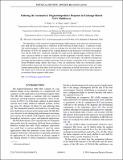Tailoring the Asymmetric Magnetoimpedance Response in Exchange-Biased
Author(s)
Kilic, U.; Garcia, C.; Ross, Caroline A
DownloadPhysRevApplied.10.034043.pdf (2.488Mb)
PUBLISHER_POLICY
Publisher Policy
Article is made available in accordance with the publisher's policy and may be subject to US copyright law. Please refer to the publisher's site for terms of use.
Terms of use
Metadata
Show full item recordAbstract
The dependence of the asymmetric magnetoimpedance (MI) response on the directions of both the magnetic field and the exchange bias is studied for an [Ni-Fe(60nm)/Ir-Mn(35nm)]×5 multilayer system. The antiferromagnetic (AFM) layers create an exchange bias that shifts both the hysteresis loop and the MI response of Ni-Fe; the strength of this coupling depends on the thicknesses of both the ferromagnetic layer and the AFM layer. Tuning the exchange-bias angle and the applied-magnetic-field direction provides a practical method to control the symmetry and the magnitude of the MI response. The observed asymmetric response can be attributed to the coexistence of two anisotropies, the induced exchange-bias anisotropy and the magnetocrystalline anisotropy. Both are distinct components of the exchange-coupled Stoner-Wohlfarth energy density that forms a basis for simulations within the conventional Landau-Lifshitz-Gilbert framework. The model reproduces the main features of the experimental results, providing a deeper understanding of the effect of the anisotropy components on the MI characteristic curve and ratio. The results can be used for the development of an asymmetric MI exchange-biased thin-film element in an autobiased linear-magnetic-field sensor.
Date issued
2018-09Department
Massachusetts Institute of Technology. Department of Materials Science and EngineeringJournal
Physical Review Applied
Publisher
American Physical Society
Citation
Kilic, U. et al. "Tailoring the Asymmetric Magnetoimpedance Response in Exchange-Biased Ni-Fe Multilayers." Physical Review Applied 10, 3 (September 2018): 034043 © 2018 American Physical Society
Version: Final published version
ISSN
2331-7019